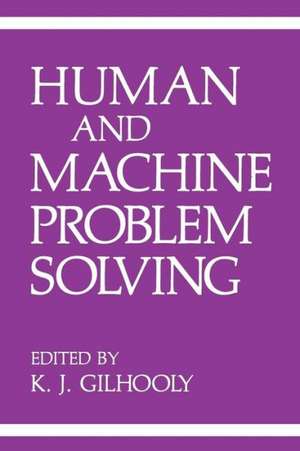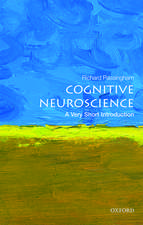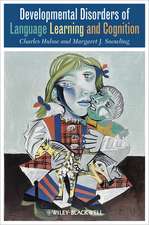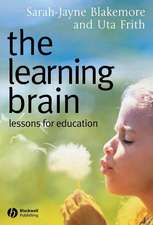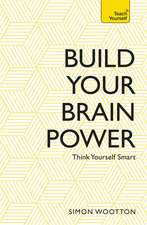Human and Machine Problem Solving
Editat de K.J. Gilhoolyen Limba Engleză Paperback – 24 apr 2012
Preț: 393.35 lei
Nou
Puncte Express: 590
Preț estimativ în valută:
75.27€ • 82.01$ • 63.42£
75.27€ • 82.01$ • 63.42£
Carte tipărită la comandă
Livrare economică 23 aprilie-07 mai
Preluare comenzi: 021 569.72.76
Specificații
ISBN-13: 9781468480177
ISBN-10: 1468480170
Pagini: 404
Ilustrații: 400 p.
Dimensiuni: 152 x 229 x 21 mm
Greutate: 0.54 kg
Ediția:Softcover reprint of the original 1st ed. 1989
Editura: Springer Us
Colecția Springer
Locul publicării:New York, NY, United States
ISBN-10: 1468480170
Pagini: 404
Ilustrații: 400 p.
Dimensiuni: 152 x 229 x 21 mm
Greutate: 0.54 kg
Ediția:Softcover reprint of the original 1st ed. 1989
Editura: Springer Us
Colecția Springer
Locul publicării:New York, NY, United States
Public țintă
ResearchCuprins
1 Human and Machine Problem Solving: Toward a Comparative Cognitive Science.- 1. Introduction.- 2. Problem Solving.- 3. Perspectives.- 4. Some Issues.- 5. References.- 2 Nonadversary Problem Solving by Machine.- 1. Introduction.- 2. State Space Representation.- 3. Problem Reduction Representation: And/or Graphs.- 4. Planning.- 5. Conclusions.- 6. References.- 3 Human Nonadversary Problem Solving.- 1. Introduction.- 2. Constraints on a Model of Human Nonadversary Problem Solving.- 3. Conclusion.- 4. References.- 4 Adversary Problem Solving by Machine.- 1. Introduction.- 2. Search Techniques for Two-Person Games.- 3. Minimaxing with an Evaluation Function.- 4. The Alpha-Beta Algorithm.- 5. Refinements of the Basic Alpha-Beta Rule.- 6. Theoretical Analyses of Alpha-Beta and Its Variants.- 7. Other Problem-Independent Adversary Search Methods.- 8. Selective Search, Evaluation Functions, and Quiescence.- 9. A Short History of Game-Playing Programs.- 10. Example of Implementation Method for Chess.- 11. Knowledge-Based Selective Search.- 12. Exact Play in Chess Endgames.- 13. Other Nonprobabilistic Games.- 14. Games of Imperfect Information, Game Theory.- 15. Conclusion—Likely Future Trends.- 16. References.- 17. Further Reading.- 5 Adversary Problem Solving by Humans.- 1. Adversary Games.- 2. Dealing with the Adversary.- 3. Characteristics of the Search Process.- 4. Plans and Knowledge.- 5. Evaluation Functions.- 6. Projecting Ahead.- 7. Humans versus Computers.- 8. Overview.- 9. References.- 6 Machine Expertise.- 1. The Automation of Problem Solving—Continuing a Tradition.- 2. Problem-Solving Knowledge Representation.- 3. The Nature of Expert Knowledge.- 4. Knowledge Representation.- 5. Problems with the Traditional Approach.- 6. Architectures for Representing MachineExpertise.- 7. The Rule-Based Approach—mycin, prospector, and xcon.- 8. The Blackboard Approach (hearsay).- 9. The Set-Covering Approach (Frame Abduction).- 10. Multiple Paradigm Approaches.- 11. Expert System Shells.- 12. Recent Developments.- 13. Conclusions.- 14. References.- 7 Human Expertise.- 1. Introduction.- 2. The Theoretical Framework: Information-Processing Theory of Problem Solving.- 3. The Construction of a Problem Representation.- 4. The Role of Schemata in Problem Solving.- 5. Problem-Solving Strategies.- 6. The Development of Expertise.- 7. Conclusion.- 8. References.- 8 Machine Inference.- 1. Input of Knowledge.- 2. Machine Inference Based on Logic.- 3. The Production-Rule-Based Approach to Inference.- 4. The Frame-Based Approach to Inference.- 5. The Current Status of Machine Inference.- 6. References.- 9 Human Inference.- 1. Introduction.- 2. The Mental Logic Approach.- 3. The Mental Models Approach.- 4. The Nature of Inference.- 5. References.- 10 Machine Learning.- 1. Introduction.- 2. Learning Concepts from Examples: Problem Statement.- 3. Learning Concepts by Induction: A Detailed Example.- 4. Learning Decision Trees and Coping with Noise.- 5. Other Approaches to Learning and Bibliographical Remarks.- 6. References.- 11 Human Learning.- 1. Introduction.- 2. Schemata, Scripts, and Frames.- 3. Amnesia.- 4. Retrieval from Long-Term Memory.- 5. Concept Learning.- 6. Conclusions.- 7. References.- 12 Problem Solving by Human-Machine Interaction.- 1. Problem Solving for the Real World.- 2. Problem Solving Reconsidered from a Human Factors Perspective.- 3. Stages of the Problem-Solving Process.- 4. Human-Computer Problem Solving: Cases.- 5. A Retrospective Example.- 6. Summary and Conclusions.- 7. References.- 8. Further Reading.- 13 Human and MachineProblem Solving: A Comparative Overview.- 1. Introduction.- 2. Nonadversary Problems.- 3. Adversary Problems.- 4. Expertise.- 5. Inference.- 6. Learning.- 7. Solving Problems by Human-Computer Interaction.- 8. Concluding Comments.- 9. References.- Author Index.
